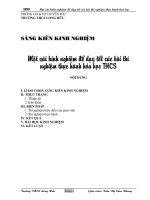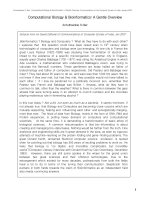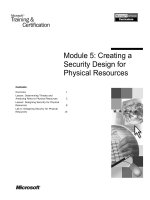Tài liệu Dollar Cost Banding - A New Algorithm for Computing Inventory Levels for Army Supply Support Activities pdf
Bạn đang xem bản rút gọn của tài liệu. Xem và tải ngay bản đầy đủ của tài liệu tại đây (992.31 KB, 132 trang )
This PDF document was made available
from
www.rand.org as a public service of
the RAND Corporation.
6
Jump down to document
Visit RAND at www.rand.org
Explore RAND Arroyo Center
View document details
This document and trademark(s) contained herein are protected by law
as indicated in a notice appearing later in this work. This electronic
representation of RAND intellectual property is provided for non-
commercial use only. Permission is required from RAND to reproduce, or
reuse in another form, any of our research documents.
Limited Electronic Distribution Rights
For More Information
CHILD POLICY
CIVIL JUSTICE
EDUCATIO
N
ENERGY AND ENVIRONMENT
HEALTH AND HEALTH CAR
E
INTERNATIONAL AFFAIR
S
NATIONAL SECURIT
Y
POPULATION AND AGIN
G
PUBLIC SAFETY
SCIENCE AND TECHNOLOGY
SUBSTANCE ABUSE
TERRORISM AND
HOMELAND SECURITY
TRANSPORTATION AND
INFRASTRUCTURE
The RAND Corporation is a nonprofit
research organization providing
objective analysis and effective
solutions that address the challenges
facing the public and private sectors
around the world.
Purchase this document
Browse Books & Publications
Make a charitable contribution
Support RAND
This product is part of the RAND Corporation monograph series.
RAND monographs present major research findings that address the
challenges facing the public and private sectors. All RAND mono
-
graphs undergo rigorous peer review to ensure high standards for
research quality and objectivity.
Prepared for the United States Army
Approved for public release, distribution unlimited
Dollar Cost Banding
A New Algorithm for Computing
Inventory Levels for Army Supply
Support Activities
Kenneth J. Girardini
Arthur Lackey
Kristin Leuschner
Daniel A. Relles
Mark Totten
Darlene J. Blake
The RAND Corporation is a nonprofit research organization providing
objective analysis and effective solutions that address the challenges
facing the public and private sectors around the world. RAND’s
publications do not necessarily reflect the opinions of its research clients
and sponsors.
R
®
is a registered trademark.
© Copyright 2004 RAND Corporation
All rights reserved. No part of this book may be reproduced in any form
by any electronic or mechanical means (including photocopying,
recording, or information storage and retrieval) without permission in
writing from RAND.
Published 2004 by the RAND Corporation
1700 Main Street, P.O. Box 2138, Santa Monica, CA 90407-2138
1200 South Hayes Street, Arlington, VA 22202-5050
201 North Craig Street, Suite 202, Pittsburgh, PA 15213-1516
RAND URL: />To order RAND documents or to obtain additional information, contact
Distribution Services: Telephone: (310) 451-7002;
Fax: (310) 451-6915; Email:
Library of Congress Cataloging-in-Publication Data
Dollar cost banding : a new algorithm for computing inventory levels for Army SSAs /
Kenneth Girardini [et al.].
p. cm.
“MG-128.”
Includes bibliographical references and index.
ISBN 0-8330-3553-3 (pbk.)
1. United States. Army—Supplies and stores—Mathematical models. 2. United
States. Army—Inventory control—Mathematical models. I. Girardini, Ken.
UC263.D65 2004
355.6'1232'0151—dc22
2003027164
The research described in this report was sponsored by the United States
Army under Contract No. DASW01-01-C-0003.
iii
Preface
Distribution Management (DM), formerly known as Velocity Man-
agement (VM), is an Army initiative to dramatically improve the
performance of key logistics processes: distribution, repair, stockage
determination, and financial management. This monograph describes
how the then Velocity Management initiative was used to develop
and implement a new algorithm for computing inventories main-
tained by Army supply support activities (SSAs). The new algorithm
is called dollar cost banding (DCB), and it departs in important ways
from the methodology that the Army had been using. First, rather
than using a single qualification logic for all items, the decision of
whether an item qualifies for stockage at an SSA is stratified based on
item cost, size, and criticality of the demands—resulting in more
items being stocked (increased breadth). Second, DCB accounts for
surges and variations in demand patterns, often driven by changes in
operational tempo, to compute the amount or depth of an item to
stock—making it more likely a part will be available on the shelf
when demands occur.
These two improvements made it possible for SSAs across the
Army to dramatically improve supply performance with little addi-
tional investment in resources (either financial or mobility).
The main body of this monograph should be of interest to Army
logisticians and leadership concerned with the management of spare
parts inventories. More generally, those studying the implementation
of supply chain improvements across large complex organizations
may find this an interesting case study. The appendixes are more de-
iv Dollar Cost Banding
tailed and descriptive of the algorithm and its inputs, and should be
of interest to those involved in the review process used to set inven-
tory levels at Army SSAs.
The Distribution Management approach to process improve-
ment used in the analysis documented in this monograph was devel-
oped through research sponsored by the Deputy Chief of Staff, G-4
(Logistics). The research was conducted in RAND Arroyo Center’s
Military Logistics Program. RAND Arroyo Center, part of the
RAND Corporation, is a federally funded research and development
center sponsored by the United States Army.
RAND Arroyo Center researchers continue to extend the Dis-
tribution Management approach, which the Army has recently re-
named Army Distribution Management (ADM), and to provide
analytic support to the Army during the implementation.
For more information on RAND Arroyo Center, contact the
Director of Operations (telephone 310-393-0411, extension 6419;
FAX 310-451-6952; e-mail ), or visit Ar-
royo’s web site at />v
The RAND Corporation Quality Assurance Process
Peer review is an integral part of all RAND research projects. Prior to
publication, this document, as with all documents in the RAND
monograph series, was subject to a quality assurance process to ensure
that the research meets several standards, including the following:
The problem is well formulated; the research approach is well de-
signed and well executed; the data and assumptions are sound; the
findings are useful and advance knowledge; the implications and rec-
ommendations follow logically from the findings and are explained
thoroughly; the documentation is accurate, understandable, cogent,
and temperate in tone; the research demonstrates understanding of
related previous studies; and the research is relevant, objective, inde-
pendent, and balanced. Peer review is conducted by research profes-
sionals who were not members of the project team.
RAND routinely reviews and refines its quality assurance proc-
ess and also conducts periodic external and internal reviews of the
quality of its body of work. For additional details regarding the
RAND quality assurance process, visit />standards/.
vii
Contents
Preface iii
Figures ix
Tables xi
Summary xiii
Acknowledgments xxiii
Glossary xxv
CHAPTER ONE
Introduction 1
Organization of Report and Intended Audience 4
CHAPTER TWO
Why Improve the Effectiveness of Army Inventories? 5
Defining the Process 5
Metrics to Identify Areas for Improvement 8
CHAPTER THREE
Developing an Improved Inventory Algorithm 15
The Process of Qualifying Items for Inventory 15
More Flexible Criteria for Determining Inventory Breadth 17
Computation of Stock Depth 20
Other Process Improvements 26
Advantages of DCB over the Army’s Traditional Inventory
Management Method 29
viii Dollar Cost Banding
CHAPTER FOUR
Implementation 31
101st Airborne Division (Air Assault) 31
Initial ASL Improvement Efforts 32
ASL Reviews Using DCB 33
3rd Infantry Division 36
Need for Improvement 37
First ASL Review with DCB 39
Second ASL Review with DCB 42
Armor Center and Armor School at Fort Knox 49
CHAPTER FIVE
Armywide Implementation 55
Approval as Army Policy 55
DCB Implementation 56
Implementation of DCB in ILAP 57
Improved Performance Across the Army 57
Continuous Improvement 59
APPENDIX
A. Guide to Appendixes: Overview of ASL Review Process 61
B. Input Files/Support Relationships 65
C. Parameters 81
D. DCB Algorithm 89
E. Simulation and Generation of Stockage Alternatives 95
F. Modified EOQ Formula 97
Bibliography 101
ix
Figures
S.1. Fill Rates for Divisions Before and After ASL Reviews
with DCB xx
2.1. The Supply Chain Can Fill a Parts Request from
Many Different Sources 7
2.2. Customer Wait Time (CWT) by Source of Fill 10
3.1. Five Steps of the Army’s Traditional Stockage
Determination Process 16
3.2. The Army’s Traditional Depth Logic Is Based on
Days of Supply (DOS) 21
3.3. The Dollar Cost Banding Algorithm Accounts for
Variations in Demand 25
4.1. Fill, Satisfaction, and Accommodation Rates for the 101st AA
Increase Steadily as DCB Was Used for ASL Reviews 33
4.2. Increases in Breadth at Fort Campbell with DCB 36
4.3. RO Value Between ASL Reviews at Fort Campbell 37
4.4. Fill, Accommodation, and Satisfaction Rates at the
3rd ID Prior to the Implementation of Dollar Cost Banding 38
4.5. Fill Rates by SSA for the 3rd ID Prior to the Use of DCB 39
4.6. Fill, Satisfaction, and Accommodation Rates for the
3rd ID Before and After DCB 42
4.7. Reductions in CWT Since ASL Redesign 43
4.8, 26th FSB Rates After DCB 49
4.9. Fill, Accommodation, and Satisfaction Rates at Fort Knox
Before and After DCB 51
x Dollar Cost Banding
4.10. Improvements in Daily Operational Readiness Rates at
Fort Knox After the Implementation of DCB 52
4.11. Decrease in Repair Time at Fort Knox After the
Implementation of DCB 53
5.1. Fill SSA Rates for Divisions Before and After ASL Reviews
with DCB 58
A.1. Overview of the Prototype Process Used to Implement DCB 62
F.1. Characteristics of the Modified Economic Order Quantity
(MEOQ) Formula 100
xi
Tables
S.1. Performance and Resource Metrics for Inventory
Management xvi
2.1. Performance Metrics for Inventory Management 9
2.2. Resource Metrics for Inventory Management 12
3.1. DCB Logic for Qualifying Items for the ASL 19
3.2. Variable CWT Goals According to Item Cost 24
3.3. DCB Provides Five Alternatives to Accommodate Different
Levels of Budget and Mobility Constraints 28
3.4. Comparison of Army’s Traditional Inventory Management
Method and DCB 30
4.1. Summary of Changes to ASLs at the 3rd ID During
the Initial Implementation of DCB 40
4.2. Summary of Five Alternatives for 3rd ID in September 2000 44
4.3. Simulation Results for the Five Alternatives Considered
for the 3rd ID in September 2000 45
4.4. Lines, Value, and Cube for the Three Alternatives
Considered by 3rd ID in September 2000 47
B.1. Structure of the File Input to the DCB Algorithm 68
B.2. Output of Demand Summary File 71
B.3. Output of Replenishment Lead Time 76
B.4. Structure of the NIIN Information File 78
C.1. Definition of Cost Bands and Associated CWT Goals 82
C.2. Add/Retain Criteria 83
C.3. AAC Not to Be Stocked 84
C.4. Identification of Low-Density Equipment Support Items 86
xii Dollar Cost Banding
C.5. Contingency Items Not to Be Deleted 86
C.6. Consignment NIINs 87
C.7. Large Items That Will Not Be Stocked 87
C.8. Phase-Out Items Identified by MATCAT, RO and
Not to Be Added or Increased 87
C.9. Sample of Cosmetic Items Screened by Nomenclature 88
xiii
Summary
When Army equipment fails, the speed with which maintenance
technicians can restore it to mission-ready condition depends criti-
cally on the availability of needed spare parts. When parts are avail-
able at the maintainer’s supporting supply support activity (SSA),
maintainers receive their orders quickly; in contrast, parts that are
unavailable at the supporting SSA might not arrive for a week or
more. But despite the advantages of having parts available from the
maintainer’s supporting SSA, Army inventory managers determining
what to stock in their deployable SSAs cannot simply base their deci-
sions on the desire to achieve a high level of customer service by
stocking as many items as possible. Instead, they must balance per-
formance goals against the realities of limited funding and storage
capacity constraints (the latter derived from the need for a highly
mobile SSA). To manage this tradeoff, the Army uses an algorithm
that tracks customer demands and computes which items to stock
and how many of each.
However, the Army was not satisfied with the existing algorithm
used to compute inventory levels for SSAs. Metrics developed under
Velocity Management (VM) suggested that performance could be
improved, and this was supported by evidence that Army maintainers
too often found that critical parts were not on the Authorized Stock-
age List (ASL) of the supporting SSA, leading to long customer wait
times, extended repair times, and reduced equipment availability.
Part unavailability could also increase maintenance workload if
maintenance technicians chose to work around a problem by remov-
xiv Dollar Cost Banding
ing needed parts from other pieces of inoperable equipment. When
no workaround was possible, repairs could not be completed until all
needed parts had arrived, thus reducing equipment readiness.
The Army’s Deputy Chief of Staff, G-4 (Logistics) asked RAND
Arroyo Center to develop a new algorithm for calculating inventory
levels in SSAs. Arroyo logisticians applied the VM three-step meth-
odology of Define, Measure, and Improve (D-M-I).
1
As part of this
process, Arroyo developed a new stockage determination algorithm
known as dollar cost banding (DCB). The idea behind the algorithm
is simple: make it easier for small, inexpensive items with high-
priority requisitions to be added to the ASL in sufficient depth so
they are available when customer requests arrive—thus improving
performance while holding down ASL storage requirements and in-
ventory costs.
Defining the Process
To set the stage for improvement, RAND Arroyo Center researchers
and other members of the VM Stockage Determination Process Im-
provement Team (SD PIT) walked the supply chain and inventory
determination processes at several Army installations. A customer’s
order can be filled from one of several inventory points: (1) inventory
held in the maintenance technician’s shop and maintained by the
parts clerk (unit-level inventory), (2) the customer’s supporting SSA,
(3) component repair, (4) referral from another SSA that supports
other customers, (5) a regional distribution center, (6) direct vendor
delivery (DVD), and (7) a backorder (when the part is not initially
available from any of the SSAs or regional distribution centers, but is
shipped when a replenishment from a repair source or vendor ar-
rives). If the customer’s request cannot be filled from unit-level in-
ventory or the supporting SSA, the requirement must be passed to
____________
1
John Dumond et al., Velocity Management: The Business Paradigm That Has Transformed
U.S. Army Logistics. Santa Monica, CA: RAND Corporation, MR-1108-A, 2001.
Summary xv
one of the other supply sources, which can be located outside the area
of operations (AOR), leading to delays.
Measuring the Process
To gain a more detailed understanding of supply chain performance,
the SD PIT developed a suite of metrics that address performance
and resource consumption. Performance metrics, explained in the
left-hand column of Table S.1, include customer service and process
diagnostic metrics. Of these metrics, customer wait time (CWT) is
particularly important for inventory managers because it focuses them
on their customers’ perspective and, implicitly, on equipment readi-
ness. Resource metrics, also shown in the table, include several met-
rics associated with inventory investment, workload, and mobility.
Improving Performance
The DCB algorithm was designed specifically to address several
problems associated with the Army’s traditional way of calculating
inventory.
More Flexible Criteria for Determining Inventory Breadth
First, DCB has made it possible to expand the breadth of deployable
inventories. Traditionally, Army SSAs used a “one-size-fits-all” ap-
proach for determining whether or not to stock a particular item.
While there are exceptions for low-density systems, an item not cur-
rently stocked would need nine requests over the prior review period
(typically a year) to be added, while an item already stocked would
need three demands to be retained.
The DCB algorithm provides greater flexibility by adjusting the
criteria for determining whether an item should be added or retained
according to the item’s criticality, mobility impact, end item density,
and dollar value. Under DCB, a small, inexpensive, but mission-
xvi Dollar Cost Banding
Table S.1
Performance and Resource Metrics for Inventory Management
Performance Metrics Resource Metrics
• Equipment readiness: the percentage
of weapon systems that are
operational.
• Customer wait time (CWT): the time
from when an order is placed by the
unit parts clerk until the item is issued.
• SSA fill rate: the percentage of
requests that are immediately filled
from the supporting SSA—whether or
not the item is on the ASL.
• Accommodation rate: the percentage
of requests for items that are on the
ASL (have an RO > 0), whether or not
the requested item is immediately
available.
• Satisfaction rate: the percentage of
accommodated requests for which
there is stock available at the time of
the request.
INVENTORY INVESTMENT
• Dollar value of the requisition
objective (RO): the value of the
maximum quantity of an item
authorized to be on order or on hand
at any time.
• Dollar value of the reorder point
(ROP): value of the point at which
replenishment is initiated.
• Dollar value of inventory greater than
the RO: value of redistributable
inventory (caused by unanticipated
customer returns or when the RO is
reduced when inventory levels are
recomputed).
TRANSITION COSTS/SAVINGS
• Transition costs: the up-front
investment needed to increase
inventory levels of existing lines or to
add new lines.
• Transition savings: credits generated
from turn-ins or draw down against
future demands, resulting from a
reduction in or deletion of inventory
levels.
WORKLOAD
• Workload: the number of transactions
by type required to fill customer orders
and maintain inventory at proper
levels.
MOBILITY
• Number of lines: number of unique
items in the ASL with an RO > O.
• Number of cubic feet represented by
the RO: sum of the cubic feet of each
item at the RO quantity.
• Number of trailers or containers:
Number of platforms used to hold
inventory.
Summary xvii
critical item might be added to inventory with only two demands per
year and retained with just one per year. The algorithm also incorpo-
rates automated checks for identifying nonessential, bulky items that
should not be stocked in deployable SSAs.
DCB Improves the Computation of Stock Depth
DCB also more effectively determines how many of a given item
should be stocked. To do so, the new approach abandons the Army’s
traditional “days-of-supply” (DOS) algorithm for determining the
quantity of each authorized item to stock. The main problem with
the DOS method for calculating depth of inventory was the under-
lying assumption that demands are uniformly distributed throughout
the year. Such a uniform distribution is almost never the case, due to
the highly variable operational tempo (OPTEMPO) associated with
Army training and deployments and the random patterns of equip-
ment failure. The DOS approach frequently resulted in stock-outs,
particularly during periods of high OPTEMPO; in other cases, capi-
tal might be tied up in a large order quantity for an expensive item.
Additionally, increased workload might result because of frequent
ordering of low-cost items.
The DCB approach is better able than the DOS approach to ac-
count for variations in demand and prevent stock-outs. It does this by
first setting an order quantity that trades off inventory holding and
ordering costs. Once the order quantity is set, an iterative simulation
routine is used to arrive at the reorder point that achieves the desired
CWT. Goals for CWT can be set based on unit price and criticality
of the item.
In each simulation, the actual demands from the two-year re-
view period are tracked against the daily inventory position. The
simulation is initiated midway between the requisition objective
(RO) and the reorder point (ROP); then each time the inventory po-
sition equals or falls below the ROP due to a demand, a replenish-
ment order is initiated, and stocks are replenished after the replen-
ishment lead time is computed from the data. After all the demands
have been processed, the average CWT associated with the current
value of the ROP is computed. A second routine adjusts the ROP,
xviii Dollar Cost Banding
and the simulation is repeated until the CWT goal is achieved. To
reach the CWT goal, the algorithm establishes a tradeoff between
safety level, order quantity, and backorder time if the item is not
available from the ASL (which affects CWT).
Automated Checks to Reduce Workload
The new DCB methodology also saves time by automating many of
the decision rules typically used by local supply managers. The algo-
rithm automatically identifies certain nomenclatures and federal sup-
ply classes (FSCs) that should not be stocked and automates the proc-
ess for identifying low-density and other items (e.g., aviation and
missile) that would normally not qualify for inventory under the “9
demands to add and 3 demands to retain” criterion (hereafter, 9/3)
but for which policy exceptions to add with three demands and retain
with just one demand have existed. This automation reduces the time
and workload necessary to conduct ASL reviews while improving
their effectiveness.
Improvements Under Dollar Cost Banding
DCB has been used successfully to conduct ASL reviews in divisional
SSAs, nondivisional tactical SSAs, and nontactical SSAs. DCB was
first used to conduct ASL reviews in the 101st Air Assault Division
and led to a significant increase in the breadth of inventory, despite
the tight mobility constraints under which the SSAs operate. For ex-
ample, after the first ASL review with DCB in 1998, the number of
unique parts stocked in the forward support battalions (FSBs) dou-
bled or tripled, while those in the main support battalion (MSB)
more than doubled. Much of the increase resulted from adding items
that cost less than $100 and had experienced high-priority demands.
The use of DCB in the 3rd Infantry Division led to an expan-
sion in the breadth and depth of certain items while reducing the
overall inventory investment and ASL mobility requirements. The
initial ASL review under DCB resulted in a 33 percent increase in the
number of stocked items (i.e., unique items stocked, referred to as
Summary xix
“lines”), with the largest increases occurring in the FSBs and the avia-
tion support battalion (ASB). The RO value of the ASLs was reduced
from $58.2 million to $53.5 million. The total cube of the parts in
the ASL was reduced and the number of trailers in the MSB was re-
duced, thus improving mobility. A second ASL review using DCB,
conducted in September 2000, resulted in further improvements. Fill,
satisfaction, and accommodation rates all rose. As a result of im-
proved ASL performance, CWT was reduced.
The use of DCB in ASL reviews has also led to improved in-
ventory performance at the Army’s Armor Center and School at Fort
Knox. As home to the Army’s tank training, Fort Knox supports a
high OPTEMPO similar to that of deployed units. The DCB rec-
ommendations at Fort Knox resulted in a net decrease in inventory
value of $1.3 million, while the number of unique parts stocked in
the warehouse almost doubled to 4,572. Unlike the deployable units
such as those found in the 101st Air Assault Division and 3rd Infan-
try Division, Fort Knox operates its SSA out of a nondeployable fixed
warehouse with considerably more storage space. With the applica-
tion of DCB, the SSA fill rate at Fort Knox improved from 41 per-
cent to 63 percent, mostly due to higher accommodation rates. As a
result, the median CWT for high-priority demands collapsed from
2–3 days to the same or next day.
Improved local fill rates and reduced CWT led to an increase in
the operational availability of the M1A1 tank fleet at Fort Knox. One
of the reasons for this improvement was an increase in the percentage
of repair jobs for which all the required parts were available from the
ASL. When all parts required for a job are stocked in the ASL, repairs
can be completed more quickly because no parts need to be requisi-
tioned from off post. Overall, the average repair time for M1A1 tanks
at Fort Knox decreased from 12.4 days to 8.8 days, a 29 percent de-
crease.
xx Dollar Cost Banding
Inventory Performance Improvements for SSAs
Across the Army
The DCB logic has been incorporated into the Integrated Logistics
Analysis Program (ILAP). At the same time, RAND Arroyo Center
has continued its research to improve the DCB algorithm. The use of
DCB has also been made part of Army policy. In 2000, DCB was
made an approved policy option for units conducting ASL reviews;
while in 2002, the use of DCB was made mandatory for ASL reviews.
Figure S.1 shows the ASL fill rates for eight active Army divi-
sions before and after the use of DCB for an ASL review.
The best performance is in the XVIII Corps divisions (the four
leftmost divisions in the figure), which were the first to use DCB in
ASL reviews. Units that have not shown as strong an improvement
Figure S.1
Fill Rates for Divisions Before and After ASL Reviews with DCB
SSA fill rate (all IPGs)
.5
.4
.3
.2
.1
.6
1st
ID
1st
AD
1st
CAV
DIV
10th
MTN
DIV
3rd
ID
101st
AA
DIV
82nd
ABN
DIV
2nd
ID
0
RANDMG128-S.1
Before DCB
After DCB
All Class IX requisitions, computed from document histories
Summary xxi
have not been able to fully leverage the recommendations from DCB
due to budget or other constraints or have conducted fewer ASL re-
views with DCB.
Continuous Improvement
The final step of any process improvement, after propagating it across
the organization, is always one of continuous improvement. The ex-
perience to date has suggested two major areas in which DCB can be
improved:
• First, the recommendations of DCB need to be better linked
to weapon system readiness. To better tailor the ASL to sup-
port readiness, RAND Arroyo Center is linking the DCB logic
with data on requisitions for parts needed to complete mainte-
nance jobs to return inoperable equipment to mission-ready
status. Such data are available through the Equipment Down-
time Analyzer (EDA),
2
which provides a systemwide view of
how much each process and organization contributes to equip-
ment downtime. Arroyo is seeking to improve upon the existing
logic of how to identify a “critical” item, then better focus in-
ventory investment and mobility resources on readiness drivers.
• Second, inventory decisions for Army Materiel Command
(AMC)-managed items need to be coordinated across eche-
lons under SSF. Under Single Stock Fund Milestone III (SSF
MS III), the inventory in tactical SSAs converted to Army
Working Capital Fund (AWCF) ownership. This shift will po-
tentially reduce some of the financial barriers to improving
ASLs. Arroyo is considering additions to the DCB logic to ad-
dress resource allocation under the new funding environment.
____________
2
Eric Peltz et al., Diagnosing the Army’s Equipment Readiness: The Equipment Downtime
Analyzer, Santa Monica, CA: RAND Corporation, MR-1481-A, 2002.
xxiii
Acknowledgments
This monograph records the achievements of a wide-ranging effort
and reflects the hard work of individuals from many organizations
who contributed to the Army’s Velocity Management initiative, the
Stockage Determination Process Improvement Team (SD PIT), and
unit Site Improvement Teams (SITs) that led to the implementation
of DCB as a viable ASL review methodology across the Army. This
represents a large change for the Army, and it would be impossible to
acknowledge all those who contributed.
However, we begin by gratefully acknowledging our debt to cur-
rent and former leaders and logisticians of the SD PIT. Most notable
for his eloquent arguments in favor of bringing change to the ASL
review process is the late MG (ret.) Jim Wright. MG Hawthorne L.
Proctor also led the SD PIT and pushed to expand the use of DCB
across the Army as quickly as possible. The tireless efforts of Mr.
Tom Edwards, Deputy to the Commanding General of CASCOM,
were invaluable to the successful implementation of DCB. LTG (ret.)
Charles Mahan, as Army G-4, and MG Daniel Mongeon, as
FORSCOM G-4, were instrumental in pushing for both implemen-
tation and policy changes. Special thanks are due to MG Mitch Ste-
venson, G-3 Army Materiel Command, and MG Ross Thompson,
Commander TACOM, for their assistance and feedback.
Both the Velocity Management team at CASCOM and the
Army G-4 staff have been important contributors to this effort. We
would like to thank COL Joe Walden, LTC (ret.) Chris Schieffer,
LTC (ret.) Tony Fuller, CW5 Leo Gibson, CW5 (ret.) John Lowes,









